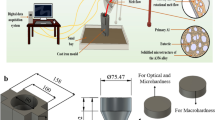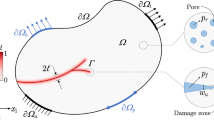Abstract
This paper deals with an analytical model of thermal stresses which originate during a cooling process of an anisotropic solid continuum with uniaxial or triaxial anisotropy. The anisotropic solid continuum consists of anisotropic spherical particles periodically distributed in an anisotropic infinite matrix. The particles are or are not embedded in an anisotropic spherical envelope, and the infinite matrix is imaginarily divided into identical cubic cells with central particles. The thermal stresses are thus investigated within the cubic cell. This multi-particle-(envelope)-matrix system based on the cell model is applicable to two- and three-component materials of precipitate-matrix and precipitate-envelope-matrix types, respectively. Finally, an analysis of the determination of the thermal stresses in the multi-particle-(envelope)-matrix system which consists of isotropic as well as uniaxial- and/or triaxial-anisotropic components is presented. Additionally, the thermal-stress induced elastic energy density for the anisotropic components is also derived. These analytical models which are valid for isotropic, anisotropic and isotropic–anisotropic multi-particle-(envelope)-matrix systems represent the determination of important material characteristics. This analytical determination includes: (1) the determination of a critical particle radius which defines a limit state regarding the crack initiation in an elastic, elastic-plastic and plastic components; (2) the determination of dimensions and a shape of a crack propagated in a ceramic components; (3) the determination of an energy barrier and micro-/macro-strengthening in a component; and (4) analytical–(experimental)–computational methods of the lifetime prediction. The determination of the thermal stresses in the anisotropic components presented in this paper can be used to determine these material characteristics of real two- and three-component materials with anisotropic components or with anisotropic and isotropic components.
Similar content being viewed by others
References
Ceniga L.: A new analytical model for thermal stresses in multi-phase materials and lifetime prediction methods. Acta Mech. Sin. 24, 189–206 (2008)
Ceniga L.: Thermal-stress induced phenomena in two-component material: Part I. Acta Mech. Sin. 25, 811–820 (2009)
Ceniga L.: Thermal-stress induced phenomena in two-component material: Part II. Acta Mech. Sin. 26, 101–106 (2010)
Brdička M., Samek L., Sopko B.: Mechanics of Continuum, 1st edn. Academia, Prague (2000)
Author information
Authors and Affiliations
Corresponding author
Rights and permissions
About this article
Cite this article
Ceniga, L. Thermal stresses in two- and three-component anisotropic materials. Acta Mech Sin 26, 695–709 (2010). https://doi.org/10.1007/s10409-010-0368-x
Received:
Revised:
Accepted:
Published:
Issue Date:
DOI: https://doi.org/10.1007/s10409-010-0368-x




